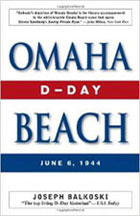| Plannifier un voyage: |  |
| |
|
 |
Raymond S. HOBACK - 29th Division.
Bedford Boys Fallen - Raymond Samuel HOBACK never had a chance to reach 100 years old today. Instead, he sacrified his life for our freedom... Raymond may have made it out of his landing craft, but he never made it to shore. Others recall seeing his body in the water. Bedford also failed to make in on the beach. He was killed by an exploding 88mm shell. Their time in the battle could be measured in minutes... [American D-Day facebook] Lire plus...
[Posté le: 2020-01-21 22:40:05]
Bedford Boys Fallen - Raymond Samuel HOBACK never had a chance to reach 100 years old today. Instead, he sacrified his life for our freedom... Raymond may have made it out of his landing craft, but he never made it to shore. Others recall seeing his body in the water. Bedford also failed to make in on the beach. He was killed by an exploding 88mm shell. Their time in the battle could be measured in minutes... [American D-Day facebook] Lire plus...
[Posté le: 2020-01-21 22:40:05]
RIP - Robert GIGUERE - Navy.
It is with heavy heart we learn the passing of Mr. Robert GIGUERE, a veteran of D-Day (Normandy)... He was 93... Four days earlier, Giguere rode across the choppy English Channel toward the Normandy coast with the Sixth Naval Beach Battalion. When his carrier grounded on the beach, a Teller mine detonated from beneath and tore through the ship's hull, Killing several soldiers below deck... [American D-Day facebook] Lire plus...
[Posté le: 2020-01-21 22:58:23]
It is with heavy heart we learn the passing of Mr. Robert GIGUERE, a veteran of D-Day (Normandy)... He was 93... Four days earlier, Giguere rode across the choppy English Channel toward the Normandy coast with the Sixth Naval Beach Battalion. When his carrier grounded on the beach, a Teller mine detonated from beneath and tore through the ship's hull, Killing several soldiers below deck... [American D-Day facebook] Lire plus...
[Posté le: 2020-01-21 22:58:23]
| 1 - 2 / 25 news |
| WOLTERS HENRY H 1ST INFANTRY DIVISION |
Honoré par Herman Wolters
[Posté le: 2024-02-29 20:28:14]
| PALMER SAMUEL C 29TH INFANTRY DIVISION |
Honoré par Jeffrey Palmer
[Posté le: 2023-12-25 14:40:54]
| 1 - 2 / 135 messages |
 |
5th Ranger Battalion, Headquarters After Action Report |
 |
| D-Day 6 June 1944. At 0530 hours the Fifth Ranger battalion loaded into L.C.A.'s from the mother ships, H.M.S. Prince Leopold and Prince Boudouin, and started the ten mile run to the coast of France. The morale of the men was excellent, the weather cloudy, and the sea very choppy.
About five miles from shore, one (1) L.C.A. containing the First Platoon and a part of the company headquarters of Company F had shipped so much water that it was forced to drop out of the formation. This platoon did not make the assault landing with the battalion but did land near the St. Laurent-sur-Mer Beach exit at 0900 after transferring to a passing L.C.T.
The beach was protected by a large number o under-water obstacles consisting of elements "C", hedgehogs and tetrahedral, many of which had Teller-Mines attached. Mortar and artillery shells were bursting in the area of these obstacles and a heavy concentration of small-arms fire swept the beach. A four foot sea-wall ran laterally along the beach about 75 yards from the water's edge. Friendly troops were observed utilizing the protective cover afforded by this wall. A pall of smoke obscured the sharply rising ground immediately in the rear of and overlooking the beach. Our naval bombardment evidently had set fire to the vegetation covering the hill. The L.C.A.'s slowly threaded their way through gaps in the lines of obstacles and at H+75, 0745, the first wave consisting of one half Battalion Headquarters, Companies A, B, and E, landed on Omaha Dog White Beach at a point approximately 800 yards east of Exit D-1. The Battalion Commander, Lieutenant Colonel Max F. Schneider, had ordered the flotilla commander to touch down his craft east of the intended landing point, Dog Green, because the tremendous volume of fire which covered that portion of the beach was inflicting a large number of casualties on the proceeding wave. The first wave crossed the beach in good order with few casualties, halted temporarily in rear of the sea wall, and immediately reorganized. The second wave, consisting of one half battalion Headquarters, Companies C; D, and one (1) Platoon of Company F, duplicated the feat of the first wave. At a signal from the Battalion Commander the leading echelon scrambled over the wall, blew gaps in the protective wire, and protected from enemy observation by the curtain of rising smoke advanced unhesitatingly to a point near the top of the hill. Here the smoke had cleared and the topographical crest was being swept by effective automatic weapons fire. First Lieutenant Francis W. Dawson, Company D, led his platoon over the top and wiped out a strongpoint thereby enabling the battalion to advance. Because of numerous mine fields the battalion now changed into a column formation and, after winding through their intricate pattern, the leading unit, Company B, reached the St. Laurent-sur-Mer - Vierville-sur-Mer road at a point approximately one (1) kilometer east of Vierville-sur-Mer. During the advance numerous Germans, well concealed in weapons pits constructed in hedgerows, were killed. Company B advanced toward Vierville-sur-Mer receiving heavy sniper and machine gun fire. Several direct hits from enemy artillery on the rear of the battalion column caused numerous casualties. Company E attempted a penetration to the South but was halted by intense machine gun fire. An 81 mm mortar concentration fired by Company C knocked out several of these positions but they were rapidly replaced and the advance remained halted. The weight of the attack was shifted toward Vierville-sur-Mer and, after overcoming considerable sniper resistance, the battalion advanced through the village to its western outskirts where it was again held up by a large volume of concerted machine gun and sniper fire. At this point contact was established with the Commanding Officer First Battalion 116th Infantry and approximately 150 men of his unit. Dusk was falling and the battalion was ordered to dig-in a perimeter defense for the night. Companies A, B, and C of the Second Ranger Battalion, numbering approximately 80 men, also assumed a portion of the defense area. Tanks of the 743rd Tank battalion moved within the defense area where they remained for the night. Except for occasional exchanges with enemy snipers and machine guns the night was one of little activity. One (1) platoon of Company A which became separated from the battalion after crossing the sea-wall proceeded through Vierville-sur-Mer to the rallying point southwest of the town, arriving there at 1600 hours. In accomplishing this feat they captured 12 Germans and killed at least an equal number. Leaving the rallying point shortly thereafter this unit fought its way through to Pointe du Hoe (the Battalion objective) and contacted the Second ranger Battalion, arriving there at about 2200 hours. The platoon from F Company which landed near St. Lauren-sur-Mer received a large amount of artillery and machine gun fire on the beach. Patrols were sent out to locate the remainder of the Fifth Battalion but were unable to gain contact. Attempting to move along the beach toward Vierville-sur-Mer this platoon was subjected to artillery fire receiving 8 casualties. After advancing 600 yards to the West the unit was engaged by a superior force and pinned down. When darkness fell the platoon retained this position. The results for the first day were about 100 prisoners taken, 150 enemy dead, and approximately 60 Rangers killed and wounded. |
||


